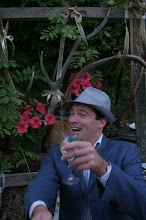 The smile says it all really. Veal. Succulent, melt in your mouth goodness.
The smile says it all really. Veal. Succulent, melt in your mouth goodness.In many countries veal is a luxury item. Dishes like blanquette de veau, tournedos de veau and escalopes viennoises are iconic. Which is why I was very surprised to find boned-out veal leg roasts at under $10 NZD a kilo. That's $2 a kilo cheaper than prime beef mince. It's unbelievable value for such a delicacy. So since coming across this find I've treated my family to two braised veal dinners and I have a third stockpiled in the freezer.
Now I've dipped into my Larousse and know he notes that 'the battery-raising of calves is a practice of debatable ethics', but I also know that in New Zealand there's a seasonal supply of dairy beef calves that go into making great young veal. Thankfully here there's no battery-raising required to get this tender, juicy meat.
Even if we weren't so lucky I don't think I'd stop eating veal; as Anthony Bourdain notes in his Les Halles cookbook: 'if I tasted that good after being locked up and immobolized in a dark shed, I wouldn't blame anyone for trying'.
That's because it's that damned good and it's a cinch to cook.
So if you're looking to establish yourself as a credentialed meat-eater then veal should certainly be on your menu.
I flicked through a few of my cook books looking for a recipe and then compared recipes with what I had in the garden, fridge and pantry and came up with this recipe below. It's a lovely and light meal. What's more, the leftover meat is fantastic either thinly cut between bread, or shredded into a tureen dish with the leftover braising liquid and left to set in the fridge.
Take one boned leg roast (1kg+)and seal it by frying in a pan. Let it get nice and golden all round.
While the roast is browning off, get out a casserole dish.
Put 3-4 crushed garlic cloves, a handful of flat-leaf parsley, and some carrots into the dish.
Take the sealed veal and put it into the casserole dish. Pour the oil from in the pan over the meat.
Get a nice big glass of white wine - I've used both a Chardonnay and a dry Gewürztraminer - and pour it over the roast. This is going to be your braising liquid. Season it all well with salt and pepper, put the lid on, put the roast into a hot oven (around 220 degrees in my current antique, which equates to around 180 in my last fan oven) and you're away.
Drop the heat back after 15 minutes and cook it for another hour.
After resting you'll have a roast that'll fall apart on the knife and you'll have to hold back the crew from tucking in before it even hits their plates.
Bon Appetite

